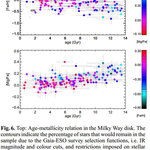Space

Why were there old, enormously massive galaxies no longer forming new stars in the very early universe?
The first stars already emerged in the very early universe about 200 million years after the Big Bang. Gas is the raw material used to form stars and giant clouds of hydrogen and helium and dust (and whatever "dark matter" will eventually be) contracted and eventually the gas became so compact that the pressure heated the matter so that glowing gas balls were formed and new stars were born.
Stars are collected in galaxies and as long as there is gas in the galaxy, new stars are…

We have learnt so much about the geology of other planets. Our spacecraft have discovered ancient oceans and rivers on Mars, and have found possible habitats for life. But we haven't discovered this life itself, and we know nothing at all about extraterrestrial biology. Why is life so hard to spot? Is it there at all, and if so, why is it hidden from view, and how can we find it?
One of the best places to look for this life might be here:
Warm-season flows on a slope in Newton Crater spread over the slopes as the year progresses
It doesn't look like much. does it; a few dark streaks that…

It's easy to see geological features in our wonderful photographs of the solar system. Life though is more elusive. We could look straight at one of its habitats and see nothing.This is a photograph of a place which scientists think may be one of the most hospitable places in our solar system outside of Earth.
It doesn't look like much, a few dark streaks that gradually spread over steep sun facing slopes on Mars in spring and summer. But these particular streaks only appear when temperatures rise above 0C. That rules out effects of dry ice, and wind, leaving liquid water as the only…

NGC 5194, also known as M51, the Whirlpool Galaxy, is one of the most spectacular examples of a spiral galaxy, with two spiral arms curling into one another in a billowing swirl, this galaxy hosts over a hundred billion stars and is currently merging with its companion, the smaller galaxy NGC 5195.
Around 30 million light-years away, the Whirlpool Galaxy is close enough to be easily spotted even with binoculars. Using the best telescopes available both on the ground and in space, astronomers can scrutinize its population of stars in extraordinary detail.
In the image below, observations…

10 years of Opportunity and Spirit on Mars have given us some interesting insights, like that the oldest minerals show that around four billion years ago Mars had liquid water so fresh it could have supported life.
NASA loves to invoke 'may have implications for life on other planets', it gets the public excited - no bucks, no Buck Rogers so selling some sizzle is important - and thus a focus for NASA's decade of research on Mars surface was whether the planet may ever have been able to be habitable.
"While Mars is too cold now to have the liquid water needed for life, we've had…

Would you want to live on a "snowball planet", covered with ice sheets and glaciers all the way to the equator? Mars only looks warm because the photos are digitally adjusted to match brighter lighting on Earth, and because it lost most of its water long ago.
It's so cold at the equator (warmest places on Mars) that carbon dioxide could freeze to dry ice at night. On Earth this only happens in the coldest spots in the interior of Antarctica in the middle of winter.
This is just one of many reasons why Mars is less than ideal as a place to live. This is an update of my Ten Reasons not to Live…

Results using data from the Gaia-ESO project has provided some evidence backing up theoretical divisions in the chemical composition of the stars that make up the Milky Way's disc – the vast collection of giant gas clouds and billions of stars that give our Galaxy its 'flying saucer' shape - and suggesting that stars in the inner regions of the Galactic disc were the first to form.
By tracking the fast-produced elements, specifically magnesium in this study, astronomers can determine how rapidly different parts of the Milky Way were formed. Using data from the VLT in Chile, astronomers…

A young star named HD 142527 in the constellation Lupus (the Wolf) has revealed that cosmic dust, which is component material of planets, is circling around the star in a form of asymmetric ring.
By measuring the density of dust in the densest part of the ring, astronomers imaging it with
the Atacama Large Millimeter/submillimeter Array (ALMA)
found that it is highly possible that planets are now being formed in that region.
This region is far from the central star, about 5 times larger than the distance between the Sun and the Neptune. This is the first firm evidence of planet…

In Trouble with Terraforming Mars, I looked at many things that could go wrong with such a project. But setting aside those issues, Mars terraforming takes us far into the realm of magical thinking - where if you can imagine something vividly, you can make it happen.
In this imagined future, with the ability to use giant space mirrors to warm up Mars, it is also easy to solve the energy crisis on Earth - just beam all the energy we need back to Earth from space solar power stations. With the fine control we need over planetary atmospheres, it is a trivial matter to adjust levels of CO2…
We haven't found life on Mars yet. That's not too surprising, though disappointing. You can see its surface geology from orbit, plain to view, but any life is likely to be hidden inside rocks, under the soil or beneath the ice.
Pristine deposits of ancient life are likely to be buried meters below the surface, or recently exposed. Any organics left on the surface for long periods of time get destroyed by cosmic radiation and some other process, probably chemical.
The only way to find it is to use surface landers and rovers, but the search may well be a long one. Our rovers on Mars have…